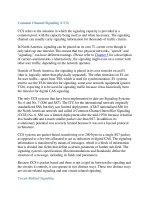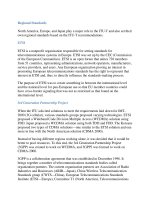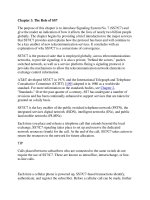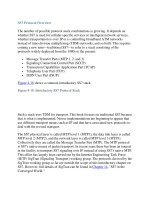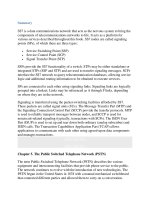Signaling System No.7 Protocol Architecture And Sevices part 27 potx
Bạn đang xem bản rút gọn của tài liệu. Xem và tải ngay bản đầy đủ của tài liệu tại đây (61.86 KB, 10 trang )
SCCP Messages and Parameters
A full list and descriptions of ITU-T and ANSI SCCP messages is provided in
Appendix C
. This section concentrates on the core messages and parameters. Table
9-3 shows the full list of SCCP messages in a chart that shows the protocol
class(es) in which the messages operate. Both ANSI [2
] and ITU-T [60] have
identical SCCP message sets.
Table 9-3. The SCCP Message Types and Corresponding Protocol Class(es)
SCCP Message
Protocol Classes
0 1 2 3
CR (Connection Request) X X
CC (Connection Confirm) X X
CREF (Connection Refused) X X
RLSD (Released) X X
RLC (Release Complete) X X
DT1 (Data Form 1) X
DT2 (Data Form 2) X
AK (Data Acknowledgment) X
UDT (Unitdata) X X
UDTS (Unitdata Service) X
[1]
X
[1]
ED (Expedited Data) X
EA (Expedited Data Acknowledgment) X
RSR (Reset Request) X
RSC (Reset Confirm) X
ERR (Protocol Data Unit Error) X X
IT (Inactivity Test) X X
XUDT (Extended Unitdata) X X
XUDTS (Extended Unitdata Service) X
[1]
X
[1]
LUDT (Long Unitdata) X X
LUDTS (Long Unitdata Service) X
[1]
X
[1]
[1]
Type of protocol class is indeterminate (absence of protocol class parameter).
M
essa
g
e Structure
Figure 9-7
shows the format of an SCCP message.
Figure 9-7. The SCCP Message Structure
[View full size image]
Apart from the absence of a Circuit Identification Code field (CIC) field following
the routing label, the basic message format is the same as an ISUP message (see
Chapter 8
, "ISDN User Part [ISUP]"). As with all other MTP users, SCCP
messages are composed of three parts: a mandatory fixed part, mandatory variable
p
art, and an optional part. All SCCP messages contain a mandatory fixed part, but
not all of them have parameters to place in the mandatory variable or optional part.
The following sections describe these three parts in more detail.
Mandatory Fixed Part (MF)
The mandatory fixed part consists of those parameters that must be present in the
message and that are of a fixed length. Because the parameters are of a fixed length
and are mandatory, no length indicator is required. In addition, because the
p
arameter types and their order is known from the SCCP message type, no
p
arameter names are required for stating the parameter types.
The mandatory fixed part contains pointers to the mandatory variable part and the
optional part of the message. A pointer to the optional part is only included if the
message type permits an optional part. If, on the other hand, the message type
p
ermits an optional part but no optional part is included for that particular message,
then a pointer field that contains all zeros is used.
N
OTE
A pointer is simply a single- or double-octet field that contains an offset, that is, a
count from the beginning of the pointer to the first octet to which it points.
Mandatory Variable Part (MV)
The mandatory variable part consists of those parameters that must be present in
the message and that are of a variable length. A pointer is used to indicate the start
of each parameter. A length indicator precedes each parameter because the
p
arameters are of a variable length. No parameter tags are required to state the
p
arameter types because the parameter types and their order is explicitly defined
by the SCCP message type. The parameters can occur in any order, but the
associated pointers must occur in the same order as specified by the particular
message type.
N
OTE
The length indicator value excludes itself and the parameter name.
Optional Part (O)
The optional part consists of those parameters that are not always necessary. Each
p
arameter is preceded by a parameter name and a length indicator. The parameter
name is a unique one-octet field pattern that is used to indicate the parameter type.
Because the parameter types and their order are unknown, it is required for each
p
arameter type.
A one-octet End of Optional Parameters field is placed at the end of the last
optional parameter. It is simply coded as all zeros.
Figure 9-8
illustrates an example message that contains all three parts. The
message could contain no optional parameters, or even more optional parameters
than in the example shown. Appendix L
, "Tektronix Supporting Traffic," includes
a trace that shows a CR message decode. The following section details the CR
message.
Figure 9-8. An Example of a Connection Request (CR) Message Structure
M
essa
g
e T
y
pes
This section details example SCCP messages that are used in both connectionless
and connection-oriented services. Appendix C
presents a full list and description of
ITU-T and ANSI SCCP messages.
Connection Request (CR)
Connection-oriented protocol Class 2 or 3 uses a CR message during the
connection establishment phase. It is sent by an originating SCCP user to a
destination SCCP user to set up a signaling connection (a virtual connection)
between the two signaling points. As shown in Table 9-4
, the various parameters
that compose the message dictate the connection requirements. After receiving the
CR message, SCCP initiates the virtual connection setup, if possible.
Table 9-4. CR Message Parameters
Parameter Type Length (octets)
Message type code MF 1
Source local reference MF 3
Protocol class MF 1
Called party address MV 3 minimum
Credit O 3
Calling party address O 4 minimum
Data O 3–130
Hop counter O 3
Importance
[1]
O 3
End of optional parameters O 1
[1]
This parameter is not present in ANSI SCCP
In GSM cellular networks, a CR message could be used between a Mobile
Switching Center (MSC) and a Base Station Controller (BSC) to setup a signaling
connection. Its data parameter could contain a BSSAP location update request or a
BSSAP handover request, for example. A description of the GSM network entities
MSC and BSC can be found in Chapter 13
, "GSM and ANSI-41 Mobile
Application Part (MAP)."
Connection Confirm (CC)
Connection-oriented protocol Class 2 or 3 uses a CC message during the
connection establishment phase. SCCP sends it at the destination node as an
acknowledgement to the originating SCCP that it has set up the signaling
connection. When the originating SCCP receives the CC message, it completes the
setup of the signaling connection. Table 9-5
shows the parameters that comprise a
CC message.
Table 9-5. CC Message Parameters
Parameter Type Length (octets)
Message type code MF 1
Destination local reference MF 3
Source local reference MF 3
Protocol class MF 1
Credit O 3
Called party address O 4 minimum
Data O 3–130
Importance
[1]
O 3
End of optional parameters O 1
[1]
This parameter is not present in ANSI SCCP [2]
Connection Refused (CREF)
The connection-oriented protocol Class 2 or 3 can use a CREF message during the
connection establishment phase. The destination SCCP or an intermediate node
sends it to indicate to the originating SCCP that the signaling connection setup has
been refused. As such, it is a negative response to a CR message. The refusal cause
value is supplied to the originating SCCP. Table 9-6
shows the parameters of a
CREF message.
Table 9-6. Connection Refused (CREF) Message Parameters
Parameter Type Length (octets)
Message type code MF 1
Destination local reference MF 3
Refusal cause MF 1
Called party address O 4 minimum
Data O 3–130
Importance
[1]
O 3
End of optional parameters O 1
[1]
This parameter is not present in ANSI SCCP [2]
In GSM cellular networks, a CREF message can be sent from an MSC to a BSC
(or vice versa) to refuse the requested signaling connection because the SCCP of
the signaling point (MSC or BSC) cannot provide the connection.
Released (RLSD)
The connection-oriented protocol Class 2 or Class 3 uses a RLSD message during
the release phase. It is sent in the forward or backward direction to indicate that the
sending SCCP wants to release the signaling connection. Table 9-7
shows the
p
arameters of a RLSD message.
Table 9-7. RLSD Message Parameters
Parameter Type Length (octets)
Message type code MF 1
Destination local reference MF 3
Source local reference MF 3
Release cause MF 1
Data O 3–130
Importance
[1]
O 3
End of optional parameters O 1
[1]
This parameter is not present in ANSI SCCP [2]
In GSM cellular networks, a RLSD message is always sent from the MSC to the
BSC (or vice versa) to release the SCCP connection and the resources that are
associated with it.
Release Complete (RLC)
The connection-oriented protocol Class 2 or 3 uses a RLC message during the
release phase. It is sent in the forward or backward direction as a response to the
RLSD message to indicate the receipt of the RLSD and the execution of the
appropriate actions for releasing the connection. Table 9-8
shows the parameters of
an RLC message.
Table 9-8. RLC Message Parameters
Parameter Type Length (octets)
Message type code MF 1
Destination local reference MF 3
Source local references MF 3
N
OTE
Do not confuse a SSCP RLC message with an ISUP RLC message. The former has
nothing to do with clearing voice circuits, while the latter does. They belong to
different user parts and are distinguished as such by the Service Indicator Octet
(SIO) described in Chapter 7
.
Data Form 1 (DT1)
Only connection-oriented protocol Class 2 uses a DT1 message during the data
transfer phase. Either end of a signaling connection sends it to transparently pass
SCCP user data between two SCCP nodes. Table 9-9
shows the parameters of a
DT1 message.
Table 9-9. DT1 Message Parameters
Parameter Type Length (octets)
Message type code MF 1
Destination local reference MF 3
Segmenting/reassembling MF 1
Data MV 2–256
DT1 messages are used in cellular networks to transfer data between the BSC and
MSC after CR and CC messages have established the connection. All data transfer
between BSC and MSC is performed using DT1 messages. DT2 messages (used
for protocol Class 3) are not used in GSM (or DCS1800).
Unitdata (UDT)
A UDT message is used to send data in connectionless mode using connectionless
p
rotocol Class 0 and Class 1. Table 9-10 shows the parameters of a UDT message.
Table 9-10. Unitdata Message (UDT) Parameters
Parameter Type Length (octets)
Message type code MF 1
Protocol class MF 1
Called party address MV 3 minimum
Calling party address MV 2 minimum
[1]
Data MV 2-X
[2]
[1]
ITU-T states a minimum length of 3, and a minimum length of 2 only in a
special case. ANSI specifies a minimum length of 2.
[2]
ITU-T states that the maximum length is for further study. ITU-T further notes
that the transfer of up to 255 octets of user data is allowed when the SCCP called
and calling party address do not include a global title. ANSI states that the
maximum length is 252 octets.
UDT messages are commonly used for TCAP communication within IN services.
In GSM cellular networks, UDT messages are used by the MAP protocol to send
its messages. For a description of the MAP protocol see Chapter 13
, "GSM and
ANSI-41 Mobile Application Part (MAP)." SCCP management messages are
transmitted using also the UDT message. SCCP management message are
described in Section SCCP Management (SCMG) and in Appendices C
, "SCCP
Messages (ANSI/ETSI/ITU-T)."
Unitdata Service (UDTS)
A UDTS message is used in connectionless protocol Class 0 and 1. It indicates to
the originating SCCP that a UDT message that is sent cannot be delivered to its
destination. A UDTS message is only sent if the option field in the received UDT
was set to return an error. Table 9-11
shows the parameters of a UDTS message.
N
OTE
UDTS, LUDTS, and XUDTS indicate that the corresponding message (UDT,
LUDT, and XUDT respectively) could not be delivered to the destination.
Table 9-11. UDTS Message Parameters
Parameter Type Length (octets)
Message type code MF 1
Return cause MF 1
Called party address MV 3 minimum
Calling party address MV 3 minimum
Data MV 2–X
[1]
[1]
ITU-T states that the maximum length is for further study. ITU-T further notes
that the transfer of up to 255 octets of user data is allowed when the SCCP called
and calling party address do not include a global title. ANSI states that the
maximum length is 251 octets.


